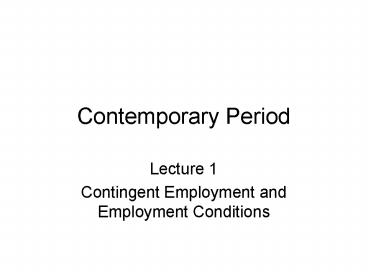Contemporary Period - PowerPoint PPT Presentation
Title:
Contemporary Period
Description:
Title: Contemporary Period Author: administrator Last modified by: Donn Created Date: 4/4/2004 7:18:19 PM Document presentation format: On-screen Show – PowerPoint PPT presentation
Number of Views:160
Avg rating:3.0/5.0
Title: Contemporary Period
1
Contemporary Period
- Lecture 1
- Contingent Employment and Employment Conditions
2
Administrative
- Reading for next time Material in Boris and
Lichtenstein (Article by Ross, Temp Blues and
Sweatshop Workers Speak Out) and Perspectives
on Work (Article by Sleigh)
3
Review
- 1970s and 1980s
- New patterns of unionism, bargaining and conflict
- Government anti-unionism
- Post-industrial society
- Women in the labor force
- White men in the labor force
- New approaches to union organizing
4
Today
- Growth of Contingent Employment
- New Technology and Employment Conditions
5
I. Growth of Contingent Employment
- Categories workers classified as contingent
- Temporaries
- Part-timers
- Seasonal workers
- Consultants
- Contractors
- Free-lancers
6
Characteristics of Contingent Employment
- Insecurity
- No career ladder
- No fringe benefits
- No unionization
- Lack of legal protections
- Many temps are really perma temps working for
the same company for years
7
Defenders of Contingent Employment
- Claim employees want the flexibility
- Provides employment that wouldnt be there
otherwise for people who need it - Employers need this to be able to compete in the
global market place
8
Opponents of Contingent Employment
- In Europe, in several countries, temporary
agencies are required to provide benefits - Part-time employees are entitled to proportional
benefits - Employers will find employees unwilling to learn
skills and insufficiently loyal
9
II. New Technology and Employment Conditions
- Physical difficulty of work
- Injuries at work
- Repetitive stress injuries
- Ergonomics
- Authoritarian rules
- on call
10
Growth of Sweat Shops
- Both in older technologies (shoes and textiles)
and in newer technologies (computers) - Employers increasingly demand that work comes
before anything else - Full service employers
11
Privacy at Work (and off)
- Electronic Monitoring
- Computer software that tracks how many key
strokes you do per minute, how many seconds you
are not working at the keyboard, what web sites
you visit - Reading employees e-mail
12
Privacy at Work (and off)
- Telephone Monitoring
- Camera monitoring
- Supermarkets and Department stores
- School buses
- Hired Investigators
- At work to check for theft
- Away from work to check on absences
13
Next Time
- Unions in the contemporary period
14
Contemporary Period
- Lecture 2
- Unions and Strikes
15
Administrative
- Reading on Union Organization, Employers and the
Law - Grady
- Roth
- Neither in BL
16
Review
- Growth of Contingent Employment
- New Technology and Employment Conditions
17
Today
- Union Membership and Organizing
- AFL-CIO
- Strikes in the Contemporary Period
18
I. Union Membership and Organizing
- What happened to union membership and union
density in the 1990s? - Tremendous number of union mergers
- Union interest in corporate governance
19
Union Organizing
- Continued failure of unions to organize fast
enough to offset membership losses - Growing organization among new groups, especially
of low wage and powerless workers - Successful organizing not based on the NLRB model
20
Union Organizing
- Organization of home health aids
- Dramatic growth of unionization among graduate
student teaching assistants - Union Network International
21
Unionization in Higher Education
- AAUP
- Yeshiva Decision (1980) Supreme Court
- Result was halt to faculty unionization in
private universities - Sudden and dramatic growth of Graduate student
unions in 1990s - Favorable NLRB decisions
- Employers responded as they always do
22
II. AFL-CIO
- No seriously contested election for president
since 1900 - 1995 coalition challenged Lane Kirkland with
President of Service Employees, John Sweeney - Forced Kirklands resignation in favor of
Secretary-Treasurer Tom Donahue - Donahue still lost to Sweeney
23
II. AFL-CIO
- New officers represented the new work force and
the new unionism - Sweeney Service Employees
- Richard Trumka United Mine Workers
- Linda Chavez-Thompson - AFSCME
24
II. AFL-CIO
- AFL-CIO accepted need to diversify its own
governing structures - Attempted to increase dramatically resources
devoted to organizing - Developed the union summer program for college
students - Union City campaign
25
II. AFL-CIO the split of 2005
- Underlying issues
- Change to Win coalition failed to gain majority
at 2005 AFL-CIO Convention - SEIU and Teamsters disaffiliated
- Retaliation
- New Federation
26
III. Strikes in the Contemporary Period
- Continued frequent use of strike replacements and
threat of strike replacements - What happened to the pattern of strikes in the
1990s? - UPS strike - 1997
27
Opportunities for Effective Strike Tactics
- Tactics of graduate teaching assistants
- Opportunities due to lean production and
just-in-time inventory management - Beginnings of international union cooperation
28
Next Time
- Union Organization, Employers and the Law































